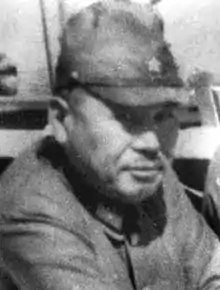Masaji Kitano
Masaji Kitano (北野 政次, Kitano Masaji, July 14, 1894 – May 17, 1986) was a Japanese war criminal, medical physician, microbiologist and a lieutenant general in the Imperial Japanese Army.
Masaji Kitano | |
|---|---|
 Kitano c. 1943 | |
| Born | July 14, 1894 Tokyo, Japan |
| Died | May 17, 1986 (aged 91) Tokyo, Japan |
| Allegiance | Empire of Japan |
| Service/ | |
| Years of service | 1921–1945 |
| Rank | Lieutenant general |
| Commands held | Unit 731, Kwantung Army |
| Battles/wars | Second Sino-Japanese War World War II |
He was the second commander of Unit 731, a covert biological and chemical warfare research and development unit responsible for some of the most notorious war crimes carried out by Japanese personnel.[1][2][3]
Biography
Masaji Kitano was born on 14 July 1894 in Hyōgo Prefecture, Japan.[4][5]
He graduated in medicine from the School of Medicine, Tokyo Imperial University on 26 November 1920 and the following year was commissioned as a lieutenant as an army surgeon.[4] In 1923 at Tokyo Imperial University's graduate school, he commenced studies in infectious diseases, intestinal perforation and shigella, and became first class army surgeon seven months later.[4] He received his doctoral degree in 1925 with a dissertation titled "Experimental research on seronegative intestine perforation and parathyroid fever", four years before being promoted to third-class army surgeon.[4]
In 1932, he worked in the First Army Hospital and taught at the Medical Department of the Ministry of War of Japan. The following year he visited the United States and Europe for research, and in August 1935 held the position of chief second-class army surgeon (Nitō guni sei).[4] In 1936, he was dispatched to Manchukuo and became a professor at the Manchu School of Medicine, teaching microbiology.[4]
In 1942, he was appointed the second commander of Unit 731. His predecessor was Shirō Ishii. In April 1945, he was promoted to lieutenant surgeon general and appointed commander of the 13th Army Medical Corps. After the Japanese surrender in August 1945, he was detained in a POW camp in Shanghai. Like all involved with Unit 731 or Japanese biological warfare, he was repatriated to Japan in January 1946.
Kitano was one of the founders of the Japanese pharmaceutical company and first commercial blood bank Green Cross, which was renamed Welfide in 1998 and which became part of Mitsubishi Pharma in 2001.[6]
In 1959, he became head of the plant in Tokyo and the chief director of that company. He was the chief funeral commissioner of Shiro Ishii.
Kitano died in Tokyo in 1986.[4]
References
- Eckart, Wolfgang Uwe (2006). Man, Medicine, and the State: The Human Body as an Object of Government Sponsored Medical Research in the 20th Century. Franz Steiner Verlag. p. 182. ISBN 978-3-515-08794-0.
- MacLeod, Roy M. (1999). Science and the Pacific War: Science and Survival in the Pacific, 1939–1945. Vol. 207. Kluwer Academic Publishers. p. 258. ISBN 0-7923-5851-1.
- Barnighausen, Till (2010). "4. Data generated in Japan's biowarfare experiments on human victims in China, 1932 – 1945, and the ethics of using them". In Nie, Jing Bao; Guo, Nanyan; Selden, Mark; Kleinman, Arthur (eds.). Japan's Wartime Medical Atrocities: Comparative Inquiries in Science, History, and Ethics. Routledge. pp. 82–91. ISBN 978-0-203-84904-0.
- Yan-Jun, Yang; Yue-Him, Tam (28 April 2018). Unit 731: Laboratory of the Devil, Auschwitz of the East: Japanese Biological Warfare in China 1933–45. Fonthill Media.
- Felton, Mark (19 July 2012). The Devil's Doctors: Japanese Human Experiments on Allied Prisoners of War. Pen and Sword. ISBN 978-1-78303-262-4.
- McCurry, Justin (29 March 2008). "Japan compensates some of its hepatitis C victims". The Lancet. 371 (9618): 1061–1062. doi:10.1016/S0140-6736(08)60469-9. ISSN 0140-6736. PMID 18380033. S2CID 7578300.
Further reading
- Romanova, Viktoriya. Shulatov, Yaroslav A. (2018) The Echo of the Khabarovsk Trials: The USSR and the Allegation Cam paign against the USA of Using Biological Warfare during the Korean War (1950–1953). History of Medicine 5(4): 262–272. doi:10.3897/hmj.5.4.35685